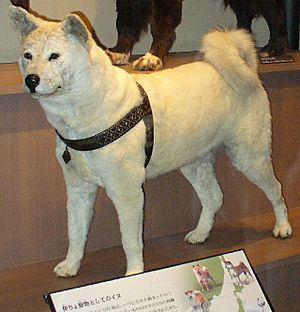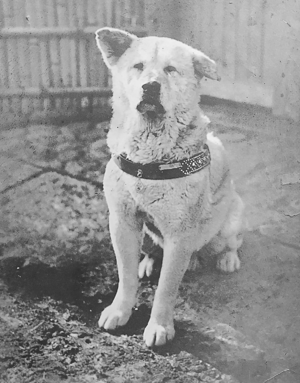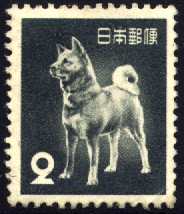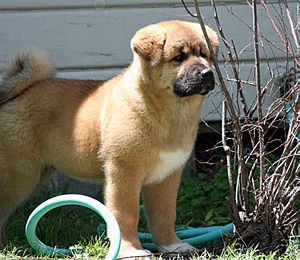Akita (dog) facts for kids
 |
|||||||||||||||||||||||||||||||||
| Other names |
|
||||||||||||||||||||||||||||||||
|---|---|---|---|---|---|---|---|---|---|---|---|---|---|---|---|---|---|---|---|---|---|---|---|---|---|---|---|---|---|---|---|---|---|
| Origin | Japan | ||||||||||||||||||||||||||||||||
|
|||||||||||||||||||||||||||||||||
|
|||||||||||||||||||||||||||||||||
| Notes | National dog of Japan, Prefecture animal of Akita |
||||||||||||||||||||||||||||||||
| Domestic dog (Canis lupus familiaris) | |||||||||||||||||||||||||||||||||
The Akita (秋田, Akita, Japanese pronunciation: [akʲita]) is a large dog breed from Japan. It comes from the snowy mountains of northern Japan and has a thick, double coat, much like other dogs from cold places. Long ago, Japanese samurai used Akitas to guard their homes, for dog fighting, and even to hunt big animals like bears.
Akitas are strong, independent, and can be a bit bossy. They might seem shy or distant with strangers, but they are very loving and loyal to their families. They are generally healthy and strong dogs. There are two main types of Akita: the pure Japanese type, called the Akita Inu or Akita-ken, and a larger type often called the "American Akita". People still discuss whether these are truly two separate breeds or just different types of the same breed.
Contents
Are there two types of Akita dogs?
Many dog experts debate if the Japanese and American Akitas are truly different breeds. As of 2020, the American Kennel Club (AKC) sees them as two separate breeds. This means they no longer allow these two types to breed together freely. Other big dog organizations, like the United Kennel Club and the Japan Kennel Club, also consider them separate.
Some countries simply call the American Akita just "Akita." In Japan, this topic is quite debated. In 1999, for 84 countries under the FCI, the American type was first called the "Great Japanese Dog." Later, in 2006, it was officially renamed the "American Akita."
History of the Akita breed
How the Akita started in Japan

The Akita Inu first came from the snowy, wild mountains of Odate, Akita Prefecture in Japan. These dogs were trained to hunt animals like elk, wild boar, and even large Ussuri brown bears. In the 1600s, Akitas were also used in dog fighting, which was popular in Japan at the time. From the 1500s to the 1800s, Akitas were companions for samurai warriors.
In 1931, the Akita was officially named a Japanese natural monument. This meant it was a special treasure of Japan. The mayor of Odate City even started a group called the Akita Inu Hozonkai to protect and carefully breed the original Akita.
In 1934, the first official rules for the Akita Inu breed were written down. This happened after the breed was declared a natural monument.
During the Russo-Japanese War, Akitas were used to track down prisoners of war and lost sailors. Later, during World War II, many non-military dogs were ordered to be killed. To save the Akita breed, some were bred with German Shepherds. Some Akitas were also used as scouts and guards during the war.
After the war, breeders worked hard to bring the Akita breed back. They mixed in other native Japanese hunting dogs, like the Matagi and Hokkaido Inu, with the remaining Akitas. This helped restore the breed. Two important Akita family lines were the Dewa and Ichinoseki lines. Many Akitas sent to other countries came from a mix of these lines.
The Dewa line was popular for a while, but Japanese breeders later felt these dogs looked too much like German Shepherds. So, they started to prefer the Ichinoseki line, which looked more like a traditional Japanese dog.
The story of Hachikō, a very famous Akita, helped the breed become known around the world. Hachikō was born in 1923 and belonged to Professor Hidesaburō Ueno in Tokyo. Every day, Hachikō would go with his owner to the Shibuya Train Station and wait for him to come home. On May 25, 1925, when Hachikō was 18 months old, he waited for his owner's train, but Professor Ueno had sadly passed away at work.
Hachikō kept waiting for his owner every day for the next nine years. He would go to the station and wait, even though his owner never returned. His loyalty became famous worldwide. In 1934, a bronze statue of Hachikō was put up at Shibuya station to honor him. This statue was melted down during the war, but a new one was built later. Every year on March 8, people remember Hachikō's loyalty with a ceremony at the station. His story became a symbol of faithfulness in Japan.
In 1967, an Akita Dog Museum was built to keep information, documents, and photos about the breed. In Japan, there's a tradition that when a child is born, they receive a statue of an Akita. This statue means health, happiness, and a long life.
In 1937, Helen Keller, a famous American author and activist, visited Japan. She was very interested in the Akita breed and was given the first two Akitas to ever come to the United States. The first dog, Kamikaze-go, sadly died young. But a second Akita, Kenzan-go (nicknamed Go-Go), became a wonderful companion to Helen Keller. She wrote that the Akita dog was "gentle, companionable and trusty."
How the Akita came to America
After World War II, the Japanese Akita and American Akita types started to become different. This was because America and Europe kept Akitas that the Japanese breeders no longer preferred, especially those with black masks or spotted markings. Japanese breeders often consider American Akitas to be mixed, but the American type actually looks more like the Akitas from before the war, including famous dogs like Hachikō.
Helen Keller is often given credit for bringing Akitas to America in 1938. By 1939, rules for the breed were set, and dog shows began. However, World War II stopped these activities. During the war, American soldiers in Japan met Akitas and were so impressed that many brought them home after their service.
Even though both types of Akitas come from the same ancestors, they have clear differences. American Akitas are usually bigger and have heavier bones, with a head that looks more like a bear's. Japanese Akitas are often smaller and have finer features, with a head that looks more like a fox's. Also, American Akitas can be any color, including spotted or with black masks. Japanese Akitas, however, are only allowed to be red, white, or brindle (striped), and they cannot have black masks or spotted markings.
The American Kennel Club (AKC) recognized the Akita in 1955. In 1972, the AKC approved the Akita's breed standard and moved it to the Working Dog group. This means the Akita is a fairly new breed in the United States. New Akitas were brought from Japan to America until 1974. Then, the AKC stopped registering Japanese imports until 1992. This decision caused the American and Japanese Akita types to become even more different over time.
What do Akitas look like?
Akitas are a type of Spitz dog, which means their appearance helps them live in cold weather. They are strong dogs with heavy bones. They have a large, bear-like head with ears that stand up and are shaped like triangles. Their eyes are small, dark, and also triangular. Akitas have thick double coats and strong, cat-like feet. Their tails curl over their backs.
Adult male American Akitas are usually about 26-28 inches (66–71 cm) tall and weigh between 100 and 130 pounds (45–59 kg). Adult females are typically 24-26 inches (61–66 cm) tall and weigh between 70 and 100 pounds (32–45 kg). The Japanese Akita type is a bit smaller and lighter.
American Akitas can have many different coat colors, including spotted, striped (brindle), solid white, or with black or white masks. Japanese Akitas, however, are limited to red, fawn, sesame, brindle, and pure white. They all have "urajiro" markings, which means they have whitish fur on their muzzle, cheeks, neck, chest, belly, tail, and inside their legs.
Akita coat types
Akitas can have two types of coats: the standard length and a long coat. The long coat is considered a fault in dog shows. This long coat, also called moku, happens when a dog gets a specific gene from both parents. These long-coated Akitas have softer fur, about 3-4 inches long, and are sometimes said to have sweeter personalities.
How to groom an Akita
American Akitas are fairly easy to care for when it comes to grooming. They often clean themselves, much like a cat. They shed a lot of fur, especially two or three times a year when they "blow out" their coats. Brushing them every day can help reduce the shedding. They need a bath every few months. Their nails should be trimmed once a month, and their ears should be cleaned once a week.
Akita personality and behavior
Akitas are usually protective of their homes and can be reserved or shy with strangers. They are sometimes described as being like cats in their actions. For example, an Akita might clean its face after eating or groom another dog it lives with. They are known to be less tolerant of other dogs of the same sex.
Because they are large and powerful dogs, Akitas are not usually recommended for people who have never owned a dog before. A well-trained Akita should be accepting of friendly strangers. They are generally good with children and are said to have a special liking for kids. However, not all Akitas have the exact same personality.
Akitas can react strongly to other dogs, so it's important to be careful when they are around unfamiliar dogs. They tend to get along less well with dogs of the same sex. Because of this, Akitas are usually not the best choice for off-leash dog parks, unless they have been socialized a lot from a young age. Akitas need a confident and consistent owner. Without proper training, they can become very stubborn and may be aggressive towards other dogs and animals.
Akita health concerns
Akitas can be prone to certain health conditions, including some that affect their immune system.
- Autoimmune diseases: These are conditions where the body's immune system mistakenly attacks its own healthy cells. Examples include skin and eye problems, blood disorders, and issues affecting the skin's oil glands.
- Immune-related hormone problems: Some hormone problems in Akitas can also be linked to their immune system. These include issues with the adrenal glands (Addison's disease), the pancreas (diabetes), and the thyroid gland (hypothyroidism).
- Other health conditions: Akitas can also experience other health issues like bloat (where the stomach twists), small eyes (microphthalmia), eye pressure problems (glaucoma), and a condition where the retina in the eye breaks down (progressive retinal atrophy). They can also have joint problems like hip dysplasia and elbow dysplasia, which affect their hips and elbows. A bleeding disorder called Von Willebrand disease can also occur.
Special conditions for Akitas
Some health issues are more common in Akitas:
- They can be sensitive to certain vaccines, medicines, and tranquilizers.
- Akitas, like some other East Asian breeds, have higher levels of potassium in their red blood cells. This can sometimes make blood tests look like they have too much potassium, even when they don't.
What jobs do Akitas do?
In Japan, Akitas were used for hunting bears, wild boar, and deer as recently as 1957. They would help hunters by finding the animals and keeping them still until the hunter could arrive.
Today, Akitas are mostly companion dogs, meaning they are pets. But they are also used as therapy dogs, helping people feel better. They compete in many dog sports and competitions, such as:
- Conformation showing: Where dogs are judged on how well they match their breed's ideal look.
- Obedience trials: Where dogs show how well they follow commands.
- Canine Good Citizen program: A test of good manners for dogs.
- Tracking trials: Where dogs follow a scent trail.
- Dog agility: Where dogs run through obstacle courses.
- Weight pulling: Where dogs pull heavy weights.
- Schutzhund: A sport that tests a dog's tracking, obedience, and protection skills.
Images for kids
-
Olympic figure-skating champion Alina Zagitova receiving a Japanese Akita in a ceremony attended by Prime Minister Shinzō Abe
See also
 In Spanish: Akita Inu para niños
In Spanish: Akita Inu para niños
- Dogs portal
- List of dog breeds
- Ginga: Nagareboshi Gin
- Hachi: A Dog's Tale
- Hokkaido (dog)
- Kai Ken
- Kishu
- Lovely Muco
- Nihon Ken Hozonkai
- Shiba Inu
- Shikoku (dog)









